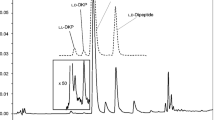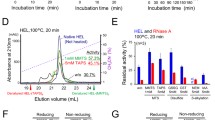Abstract
The effect of chemical crosslinking of invertase with a homo-bifunctional bisimidoester on its pH stability was studied. Dimethyl suberimidate (DMS) was used as the crosslinker and pH inactivation was investigated in the pH range of 2.5–10. The inactivation mechanisms of both native and DMS crosslinked invertases were observed to follow first-order kinetics during prolonged incubation. Although DMS crosslinking of invertase increased the pH stability of the enzyme over the complete pH range, it was especially effective over the acidic range. The half-lives of invertase increased almost twofold, on average, by crosslinking at the neutral to the acidic range. The effect of crosslinking was especially pronounced at pH 5 since both the half-life of the native invertase and the stabilization factor were very high. Higher activation free energies of inactivation were obtained for DMS crosslinked invertases over the whole pH range which also indicates the stabilization of invertase by crosslinking.
Similar content being viewed by others
References
Cox, C.P. 1987 A Handbook of Introductory Statistical Methods. New York: John Wiley and Sons, Inc.
Dixon, M., Webb, E.C., Thorne, C.J.R. and Tipton, K.F. 1964 Enzymes. New York: Academic Press.
Gianfreda, L. and Scarfi, R. 1991 Enzyme stabilization: state of the art. Molecular Cellular Biochemistry 100, 97–127.
Hartree, E.F. 1972 Determination of protein: A modification of the Lowry method that gives a linear photometric response. Analytical Biochemistry 48, 422–427.
Kazan, D., Ertan, H. & Erarslan, A. 1996 Stabilization of penicillin G acylase against pH by chemical cross-linking. Process Biochemistry 31, 135–140.
Miller, G.L. 1959 Use of dinitrosalicylic acid for determination of reducing sugar. Analytical Chemistry 31, 426–428.
Myrback, K. 1969 Invertases. In The Enzymes, eds P.D. Boyer, P.D., Lardy, H. & Myrback, K. Vol. 4, pp. 379–395. London: Academic Press.
Neumann, N. & Lampen, J.O. 1967 Purification and properties of yeast invertase. Biochemistry 6, 468–475.
Reddy, V.A. & Maley, F. 1990 Identification of active site residue in yeast invertase by affinity labelling and site-directed mutagenesis. Journal of Biological Chemistry 265, 10817–10820.
Reddy, V.A. & Maley, F. 1995 Identification of cysteine-205 as a catalytic residue in yeast invertase. FASEB Journal 9, A1295.
Rodriguez, L., Ruiz, T., Villanueva, J.R. & Sentandreu, R. 1987 Yeast invertase subcellular distribution and possible relationship between isoenzymes. Current Microbiology 1, 41–44.
Tae, H.J. 1983 Bifunctional reagents. Methods in Enzymology 91, 581–608.
Author information
Authors and Affiliations
Rights and permissions
About this article
Cite this article
Kaplan, O., Bakir, U. The effect of chemical crosslinking of invertase with dimethyl suberimidate on its pH stability. World Journal of Microbiology and Biotechnology 14, 277–280 (1997). https://doi.org/10.1023/A:1008806818784
Issue Date:
DOI: https://doi.org/10.1023/A:1008806818784




